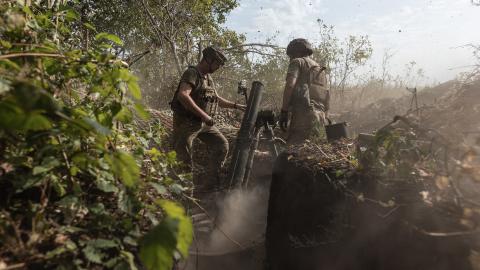Below Senior Fellow Can Kasapoğlu offers a military situation report about the war in Ukraine.
Executive Summary
• Ukraine’s defensive position in Pokrovsk continued to deteriorate rapidly.
• Russia hit an orphanage and children’s rehabilitation clinic in the Ukrainian town of Sumy, demonstrating the human cost of the Kremlin’s indiscriminate missile and drone salvos.
• The Ukrainian military held the territory it has captured in the Russian region of Kursk.
• Ukrainian drones targeted Russia’s energy infrastructure with a massive strike package.
• Kyiv lost its first F-16 fighter aircraft in combat.
1. Battlefield Assessment: Russian Forces Threaten Pokrovsk
Ukraine’s defensive position near Pokrovsk, a city in the country’s east, continued to deteriorate as Russian combat formations moved to within six miles of the town. The Kremlin flew in reinforcements to help assault the vulnerable city and has refused to relocate troops from the area to defend against Ukraine’s incursion into the Russian region of Kursk.
Visuals from Pokrovsk reveal a crowded battlefield that has hosted many high-risk engagements. Russia has shown the ability to weather high casualty rates, and Ukraine lacks the manpower to withstand the Kremlin’s meat grinder. Though the Ukrainian high command has fielded the 25th Separate Airborne Brigade, the 68th Jaeger Brigade, and the 151st Separate Mechanized Brigade against the Russian assault on Pokrovsk, Kyiv lacks sufficient forces to further augment its lines of defense. Unless Ukraine introduces more troops to the fight and drastically alters the force-on-force and force-to-terrain ratios, it risks losing the critical town.
The loss of Pokrovsk would be significant, as the city serves as a logistics hub for other front lines in the region. Hudson Institute field tours in Ukraine have observed how the Ukrainian military depends on the nation’s rail and highway network to move troops, food, and ammunition. Because Pokrovsk is a critical hub where multiple roads and rail lines intersect, the city’s fall would impact areas from Vuhledar, the site of recent heavy clashes, to Horlivka.
Because the city is only 11 miles from Dnipro Oblast, rapid success in Pokrovsk could enable Russia to launch further assaults. United Kingdom Defence Intelligence has concluded that although the Kremlin’s operational tempo in the region has slowed down, Russian forces are still making progress. Because Kyiv lacks the additional combat formations to reinforce and stabilize the front lines, the Ukrainian National Guard has deployed one of its few offensive brigades, the Kara-Dag Brigade, to Pokrovsk. This deployment highlights the high stakes involved in the city’s defense.
Elsewhere, Russia and Ukraine continued to exchange long-range strikes. On September 2 and 3, the Kremlin hit Ukraine with North Korean ballistic missiles and Iranian loitering munitions alongside native Russian missiles and glide bombs. The composition of Moscow’s strike packages confirms that Ukraine is fighting a hostile coalition rather than solely Russia.
The Kremlin also continues to launch indiscriminate air and drone salvos against civilians. On September 2, the Russian Aerospace Forces (VKS) hit a children’s rehabilitation clinic and orphanage in the Ukrainian town of Sumy. Ukraine, on the other hand, has focused its long-range drone strikes on Russia’s energy infrastructure in an effort to reduce the Kremlin’s hydrocarbon revenues. In an unprecedentedly large strike on September 1, Ukraine reportedly launched 158 drones against multiple refineries in Russia, including some in the vicinity of Moscow. These strikes reflect Ukraine’s strategy of disrupting Russia’s energy supply and weakening its economy.
The Ukrainian Air Force lost its first F-16 fighter aircraft last week, and the aircraft’s pilot, Lieutenant Colonel Oleksii Mes, died in action. The Ukrainian General Staff attributed the loss to a Russian missile barrage, noting that the F-16 was lost only after it successfully intercepted several incoming projectiles. Ukraine recently fired the commander of its air force, Mykola Oleshchuk, but the Ukrainian Ministry of Defense stated that the decision was a scheduled staff rotation and had nothing to do with the downing of the F-16.
2. Ukraine Continues Offensive Combat Operations in Kursk
Nearly one month after detachments from the Ukrainian Armed Forces first poured into the Russian region of Kursk, Kyiv’s campaign in enemy territory continues to make gains. This week Ukraine captured areas near the Russian towns of Malaya Loknya, Staraya, Orlovka, Pogrebki, Novaya Sorochina, and Mar’ivka. Open-source intelligence suggests that Ukraine is still transferring units to the Kursk front, albeit at the tactical level.
Evidence also indicates that the Kursk battlefield has stabilized. Ukraine continues to conduct stability operations and outreach efforts with the local population in the rear area. Nonetheless, Russian artillery units hit Ukrainian positions daily. Satellite imagery reveals Russian engineering formations erecting defensive positions deep inside Kursk. These positions are likely designed to guard against a reloaded Ukrainian push, perhaps in the direction of the region’s nuclear power plant, though at present this remains unlikely.
Russian engineering units are also working to establish pontoon bridges across the Seym River to allow follow-on forces to join the fight; while the Ukrainian military has destroyed five of these bridges, Russian units built a sixth last week. Yet Ukraine continues to take advantage of the permissive Russian air defenses over Kursk. Evidence suggests that the Ukrainian Air Force can still fly its MiG-29 fighter aircraft and conduct combat sorties with joint direct attack munitions (JDAMs) over the Russian border. Though Ukraine is likely to maintain a presence in Kursk for the foreseeable future, successful deep strikes against the Russian rear could help Kyiv shape the battleground to its advantage.
Subscribe to Hudson’s Re: Ukraine Newsletter Here


















